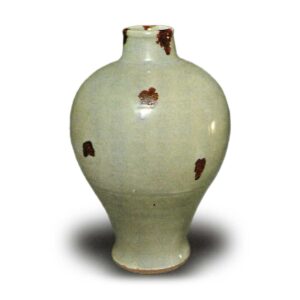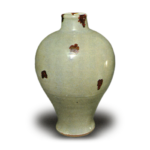
Celadon porcelain with iron-painted reddish-brown flecks on the underside. This type of celadon was highly prized in Japan from ancient times, and only a few examples have survived. The glaze and body are similar to those of Kinuta celadon, but there are some differences. The color is slightly greenish with a high transparency, and the lipstick is finer and more elaborate. The flying spots are artificial and do not occur naturally. One theory suggests that the iron glaze was filled in to repair the shrinkage of the glaze and the piece was put back into the kiln, but no evidence of this has been found. This type of flying celadon is believed to have been produced at the Longquan kilns in China from the Yuan dynasty. The flying celadon with the two-character Gu mark is said to have been made by the master Longquan potter Gu Shicheng during the Ming dynasty’s Zhengzheng era (1436-149), but the glaze, body, and workmanship of this famous hand-made flying celadon are somewhat different from those with the Gu mark, giving it a more ancient feel. It is likely that fei celadon was not limited to a certain period, but was a style favored throughout the Ming dynasty. (Shina celadon porcelain study)








